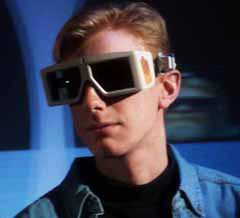LCD Shutter Glasses for Stereo Imagery in VR
September 1st, 1991 - November 30th, 0999
Categories: Devices

About
The CAVE, ImmersaDesks, I-Wall and PARIS virtual reality (VR) systems developed at EVL display active stereo images by use of StereoGraphics Liquid Crystal Display (LCD) shutter glasses. The computer generates two images, one for the left and one for the right eye; the user wears the wireless glasses, which alternately block and pass images to create the stereo effect. The computer system generates left and right eye images sequentially. An infrared signal synchronizes the glasses to the computer images, so that the right image is shown when the right lens is transparent and the left image is shown when the left lens is transparent. Infrared emitters are placed throughout and around the VR display environment, so that regardless of where the user “looks” the glasses are fully functional.
The tracker, attached to the stereo glasses finds the position of the user’s head, enabling the CAVE software to calculate and update the images from the user’s perspective. In the CAVE, it is also necessary to synchronize in stereo the four projected video displays that make up the three walls and the floor.
The CAVE, ImmersaDesk, I-Wall and PARIS systems use active shutter glasses instead of the passive polarized glasses used in 3D cinemas for a variety of reasons. In 3D cinema, left and right eyes are multiplexed by the plane of polarization with one polarization angle for the left and one polarization angle for the right eye. These systems are rear-projection displays, which tends to depolarize light as it passes through the screen material. This is especially true at the large viewing angles, 90 degrees and greater, that are common in EVL’s VR systems.
Current research includes investigating polarize preserving screen materials for use with passive stereo, and the development of front-projection VR instrumentation suitable for this technology.